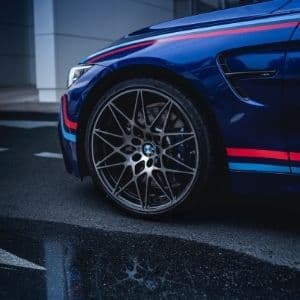Driving a BMW with Run Flat Tyres – The Good and the Bad

In 2009, BMW decided to fit all of its models with run flat tyres as standard. The brand’s collaboration with Bridgestone provided customers with improved fuel economy and a safer method of punctured tyre replacement.
To help BMW owners decide whether to keep theirs, we’ve highlighted the pros and cons.
What are run flat tyres?
There are two main types of run flat tyres – self-healing and self-supporting.
- Self-healing tyres - created by Continental, automatically seal any puncture. The technology reduces the amount of air lost compared to a standard tyre with a puncture. However, it’s often deemed the less efficient run flat option because it allows air to leave before the sealing layer becomes active.
- Self-supporting tyres - as used on BMWs, contain a lightweight metallic ring to support the car’s weight once a puncture has been made. They also have reinforced side walls to ensure that the bead stays in contact with the wheel rim – this often slips away on punctured conventional tyres, creating contact between the rim and the road..
What are the benefits of run flat tyres?
The major reason is that you can continue to drive and maintain control of your car with punctured run flats for about 50 miles at a speed of 50mph.
This means motorway drivers won’t need to immediately pull over or take the risk of changing the tyre themselves.
Removing the heavy spare wheel and tyre also improves fuel economy.
Although they are not impervious to blow outs, the support ring protects BMW’s wheels from making contact with the road. This means drivers can find a convenient place to have their tyres changed without worrying about the far more expensive cost of replacing damaged alloys.
What are the disadvantages of run flat tyres?
Drivers that took bends at quicker speeds claimed that the car jittered because of the lack of flexibility in the tyre wall.
It’s also claimed that tread wears down quicker, which could mean more frequent tyre replacements to comply with UK driving laws.
Can run flat tyres be repaired?
A punctured run flat tyre is a temporary fix as the tyre still needs replacing.
Can run flat tyres be replaced with normal tyres?
Drivers often rely on the fix-a-flat kit which fills the punctured tyre with sealant and inflates it back to the recommended PSI. The only problem with this backup is the mess it leaves.
Remember to check your manufacturer’s warranty and insurance policy to find out whether a change will void them.
BMWs: run flat tyres vs regular – which is best?
The safety benefits that run flat tyres provide in the event of a blowout or puncture can potentially save you from swerving from the inside lane on a main road to stop in the hard shoulder.
You should consider the savings that accumulate from the improved fuel economy they provide, in addition to how many times you suffer from a puncture.
So, the decision is yours entirely on whether to replace your BMW’s run flat tyres and this is largely down to how you drive.
If you need any assistance on cheap tyres online, our live chat option is available during UK office hours.
10 Nov 2016
Did you enjoy this blog post?
|
171 people found this review helpful
